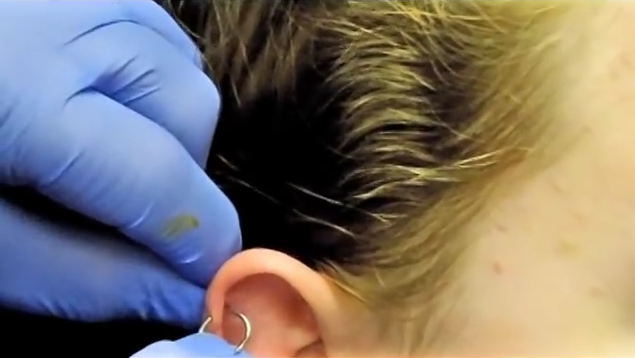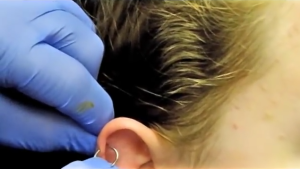Cartilage piercing is one of the popular forms of body piercing. It involves piercing of the cartilages in the nose and the ears. Some well-known forms of cartilage piercing include helix piercing, daith piercing, tragus piercing, rook piercing, and industrial piercing, etc. Cartilage piercing can damage the tissue of the skin, thereby causing infections and bumps on skin.
Cartilage piercing – Procedure and Price
- Cartilage piercing can be done at home. But for better results and satisfaction, it is best to get the piercing done by a professional. Do not pierce the cartilage of the nose or the ears via a gun shot, as it is possible that the same device may be used for all, thereby increasing the risk of infections.
- The procedure of cartilage piercing differs slightly as per the area of the nose or ear that is being pierced. For example, the piercing professional may use a curved needle or an eighteen-gauge hollow needle to puncture the tragus.
- First, the professional will place a cork in the ear opening to prevent unwanted items from entering the ear canal. The piercing area as well as the adjacent areas are scrubbed with a surgical cleanser. A surgical pen is then used to mark the areas, on the inside as well as the outside, that are to be pierced. The head needs to be kept still during the procedure. Hence, you may be asked to lie down on the back.
- The needle is sterilized with alcohol and placed over the marking. Then force is applied on the needle so as to pierce the cartilage. As cartilage is tougher than normal skin, the piercing professional will apply greater than normal force to pierce it.
- Once the hole is made, a jewelry is inserted into the piercing. You may choose from a variety of jewelry items such as rings with beads, curved or straight barbells, etc. The jewelry can be made of surgical stainless steel, gold, or titanium.
- Price: The cost of cartilage piercing tends varies according to different factors such as the skills and reputation of the piercing professional, the number of piercings, the type of jewelry, the location (cities or small towns), etc. In most cases, a single sitting for cartilage piercing can cost upwards of $15.
Cartilage piercing – Infection and bumps
Some of the common symptoms and causes of possible infection and bump development at the piercing site are listed below:
- Symptoms: Any kind of body piercing, including cartilage piercing, is usually followed by swelling, pain, and redness on the pierced spot and sometimes around it. A whitish fluid generally drains out from the piercing area. This fluid is not pus, but lymphatic fluid which helps in cleaning dirt, bacteria, and other germs.
- After a few days, the pierced spot will develop a yellowish crust, an indication that the cartilage piercing has started to heal. It may however be noted that this may not occur in all instances of cartilage piercing.
- Occasionally, and often when the necessary ‘after-care’ and precautionary measures are not followed, people may develop infections and other problems at the cartilage piercing site. Infections are usually accompanied by symptoms such as bleeding, throbbing pain, inflammation, formation of pus, foul odor, development of a bump, migration or dislodgement of the piercing, fever, stretching of the pierced site, and skin irritation.
- Causes: The skin can get irritated or experience friction when a jewelry is inserted into it. This can trigger the formation of pus-filled bumps or blisters. Such bumps or blisters have to drain out. However, if the cartilage piercing jewelry is a stud that fits snugly onto the skin, then fluid/pus drainage may be obstructed thereby worsening the associated infection.
- When the cartilage is pierced via a gunshot then the soft tissue occurring between the back of the skin and the cartilage can get damaged. Such guns also exert pressure on the cartilage and push it out, which in turn causes a shapeless bump to form at the site.
- Boils may form at the cartilage piercing site, if the jewelry is made of an allergic substance, or it is pulled or gets snagged when sleeping. These boils may be painful and/or drain pus or blood.
- Migration of the piercing from the original site can result in skin irritation and formation of bumps. Overuse or incorrect use of disinfectants can also trigger the development of bumps.
- New collagen is produced by the body during the healing period. Excessive production of collagen can result in the formation of scarring known as a hypertrophic scar. Exertion of elevated pressure on the pierced site or the use of incorrect type of jewelry can also trigger hypertrophic scarring and subsequent formation of a bump in the region.
- Collagen overgrowth can also give rise to keloid scars, which unlike hypertrophic scarring, can spread to areas other than the pierced site.
Treatment of cartilage piercing infections
Severe cases of cartilage piercing infections are treated with antibiotics. Doctors may prescribe topical creams for keloid or opt for their surgical removal to prevent any complications.
The below listed home remedies can help resolve minor cases of cartilage piercing problems:
- Soak a tea bag of chamomile tea in hot water for 1 to 2 minutes and then apply on the affected site. This is especially helpful for stubborn cartilage piercing bumps.
- Cartilage piercing bumps can be eliminated by applying a mixture of warm water and sea salt on the affected area. Wash the area after letting in remain for about 5 to 10 minutes. In case the sea salt soak is used on boils, then the resultant crust formed due to pus drained also need to be cleaned using cotton swabs.
- Crush an aspirin tablet, combine with water and make a paste, apply on the affected site. The paste will soak into the skin, open up the blood vessels, improve circulation, and help speed up the healing process.
- Application of tree tea oil can also help kill bacteria and speed the healing process.
Consult a doctor or a piercing professional to get information about the after-care measures and precautions that need to be followed so as to prevent infection and other problems of a cartilage piercing.

